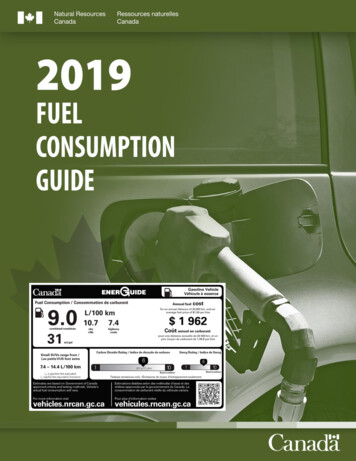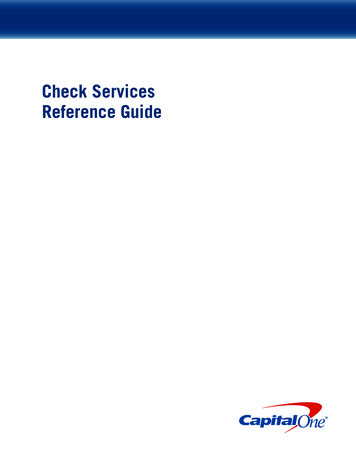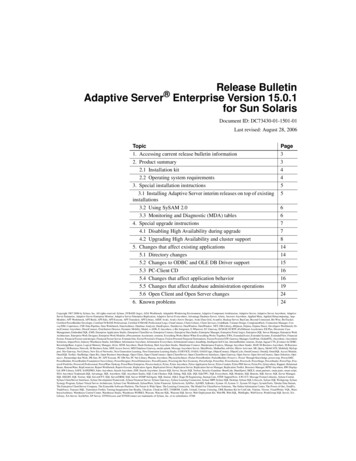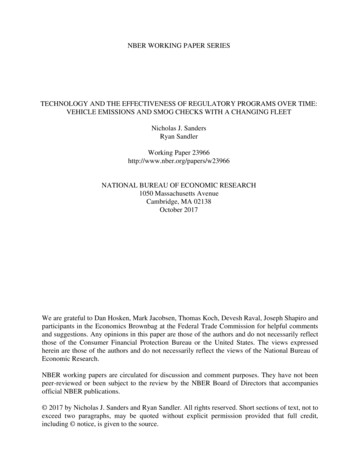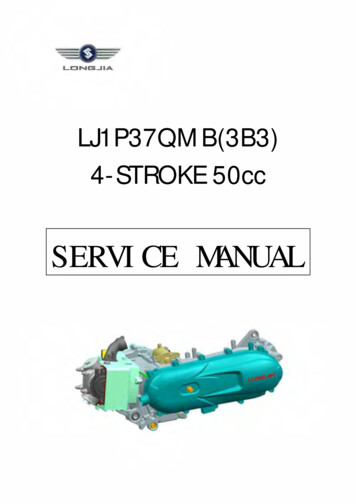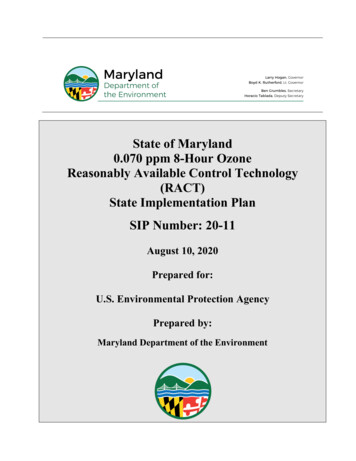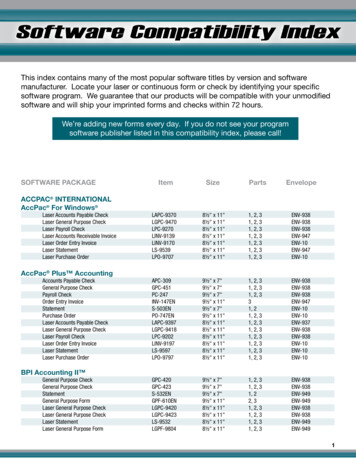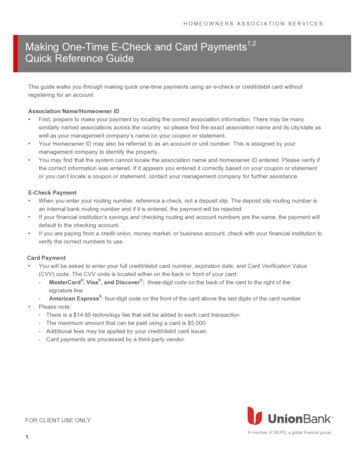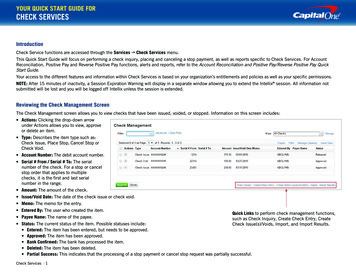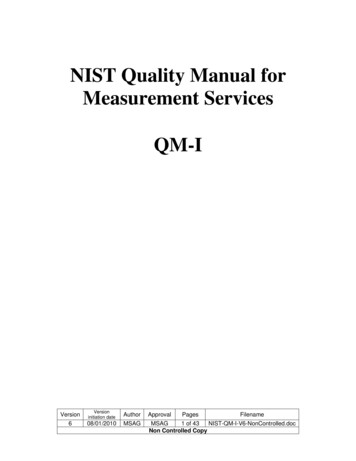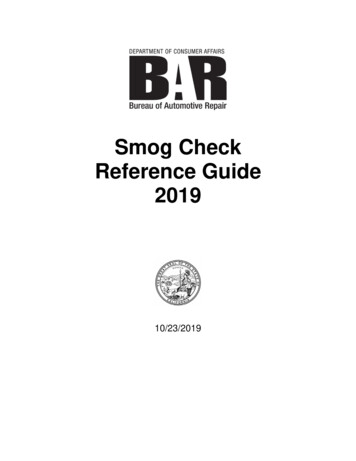
Transcription
Smog CheckReference Guide201910/23/2019
PREFACEThis guide is intended to serve as a reference for Smog Check stations, inspectors, and repairtechnicians. It provides information to assist licensees comply with Smog Check Programrequirements, including the following areas: Section I - Program Description: General program and administrative requirements forSmog Check stations, inspectors, and repair technicians. This section also includesinformation for miscellaneous inspection scenarios. Section II - Repair and Retest: Information for repair technicians conducting repairs inall program areas. Section III - BAR Referee: Information on Referee test services.The Bureau of Automotive Repair may periodically distribute supplemental bulletins containinginformation on changes in laws, regulations, or other related material. These supplementsshould be maintained with this guide for easy access and reference. For complete informationon Smog Check procedures, refer to the Smog Check Manual available at www.bar.ca.gov.Suggestions for improvement to this guide are welcome and should be directed toBAR.IndustryHelpDesk@dca.ca.gov.i
REVISION TABLERevisionNumberRevisionDateRevision Description2.1Updated: Engine Change Guidelines; Updated Licensing phonenumberRemoved: Aftermarket Parts Verification Guidelines (Smog CheckManual)Added Smog Check Requirements by Vehicle Type Table5/15/20193.0Corrected Biennial Model Year Exemption; ADA Format10/23/20191.02.0ii5/11/201811/1/2018
TABLE OF CONTENTSPreface .iRevision Table . iiSection I – Program Description . 11.1 General Information . 11.1.0Overview . 11.1.1Program Areas . 11.1.2Smog Check Information/Website . 21.1.3Smog Check Laws and Regulations . 21.1.4Affected Vehicles. 31.1.5Exempted Vehicles. 31.1.6Rejected Vehicles. 51.1.7Transfer of Ownership . 51.1.8Directed Vehicles . 61.1.9Gross Polluters . 61.1.10Electronic Transmission Network . 71.1.11Smog Check Certificate Purchases . 81.2 Station Definitions. 91.2.0Test Only Stations . 91.2.1Repair Only Stations .101.2.2Test and Repair Stations .101.2.3State Referee .111.2.4STAR Station Certification .111.3 Station Licensing Requirements .121.3.0Station Licensing Procedures .121.3.1License Duration .121.3.2License Fees .131.3.3Replacement License .131.3.4Stations Ceasing to Operate .131.4 Equipment Requirements .141.4.0Station Equipment and Materials .141.5 Licensed Inspector and Repair Technician Requirements .151.5.0Inspector and Repair Technician Requirements .151.5.1Licensee Expectations.151.5.2Smog Check Inspector .161.5.3Smog Check Repair Technician .17iii
1.5.4License Expiration Date.181.5.5Additional Information for Licensed Inspectors and Repair Technicians .181.5.6Suspension and Revocation of Licenses .191.6 Station Operation.201.6.0Work Area .201.6.1Licensed Inspector and/or Repair Technician Required.201.6.2License Display .201.6.3Posting of Prices .201.6.4Records .211.6.5Smog Check Signs .211.6.6Unlicensed Activity .221.6.7Availability to the Public/Full Service to Customers .221.6.8Sublet Inspection and Repair.231.7 Station Audits .241.7.0BAR Station Audits .241.8 Repair Assistance, Cost Waivers .251.8.0Consumer Assistance Program .251.8.1Repair Cost Waivers .251.9 Customer Authorization .271.9.0Estimate Preparation .271.9.1Station Obligations .281.10 Miscellaneous Inspection Scenarios .291.10.0Garaged Outside Program Area .291.10.1Motor Homes.291.10.2Specially Constructed (SPCNS) Vehicles or Kit Cars .291.10.3Fleet Vehicles .301.10.4Military Personnel Vehicles .311.10.5Clearance of Enforcement Documents .311.10.6Smog Check Help .31Section II – Repair and Retest Procedures .322.1 Vehicle Repair .322.1.0Repair General Overview .322.1.1Repair Estimate .322.1.2Repair Standards .322.1.3Pre-Repair Verification .332.1.4Priority of Repairs .33iv
2.1.5“Non Smog Check” Repair Dealers .332.1.6Sublet Repair .342.1.7Owner Repairs .342.1.8EIS Manual Testing Mode .342.2 Vehicle Warranty .362.2.0Emission Control System Warranty .362.2.1Warranty Repair Requirements .362.2.2California Emissions Control Warranty .362.2.3Federal Warranties .372.2.4Independent Repair Dealer .37Section III – BAR Referee .383.1 Referee Services .383.1.0Referee Inspection Services .383.1.1Referee Appointments .393.1.2BAR Referee Label .39Appendix A: Definitions and Abbreviations List .40Appendix B: List of Bureau of Automotive Repair Field Offices .43Appendix C: Important Telephone Numbers and Websites .44Appendix D: State of California – Engine Change Guidelines .45Appendix E: Alternative Fuel Powered Vehicles .49v
Section I – Program DescriptionSECTION I – PROGRAM DESCRIPTION1.1 General Information1.1.0 OverviewIn response to amendments of the Federal Clean Air Act, Assembly Bill 2018 was passed by thelegislature and signed into law in 1994. This legislation required loaded mode emissions testingfor vehicles registered in areas of the state that have not achieved federal air quality standards("Enhanced Areas"). The state’s less polluted areas (Basic and Change of Ownership Areas)continued to use a two-speed idle emissions test mode.In 2010, Assembly Bill 2289 was signed into law. This legislation modernized the program byemploying an OBD II focused inspection for 2000 model-year and newer vehicles.1.1.1 Program AreasThe Smog Check Program divides the state into three areas determined by the air quality in thedesignated area. While the OBD II focused inspection is required statewide for most 2000model-year and newer vehicles, 1976-1999 model-year vehicles may receive a differentinspection, depending on program area.Generally, the area in which a station is located determines the station license types and thestation equipment requirements. For more station equipment information, see section 1.4.0.Smog Check certification is required in all program areas when an affected vehicle changesownership, with the exception of gasoline vehicles four or less model-years old. Certification isalso required in all areas when a vehicle is initially registered in California.Enhanced Areas: These areas do not meet federal or state air quality standards for ozone andcarbon monoxide. Biennial Smog Check inspections are required in these areas, in addition tothe change of ownership and initial registration inspection requirement.Additionally, a portion of the vehicles in Enhanced Areas must receive their biennial SmogCheck at a STAR certified test only station or a STAR certified test and repair station. In order tomeasure NOx emissions, most Enhanced Area 1976–1999 model-year vehicles are subject to adynamometer loaded mode emissions test.Basic Areas: Basic areas are less polluted then Enhanced Areas; however, due to theirmarginal air quality, biennial inspections are required. Basic Area 1976 - 1999 model-yearvehicles are subject to a two-speed idle test. Loaded mode tests are not required in BasicAreas.Change of Ownership Areas: These more rural areas of the state require Smog Checkcertification only when an affected vehicle changes ownership (with the exception of gasolinevehicles four or less model-years old) or is initially registered in California. Change of OwnershipArea 1976-1999 model-year vehicles are subject to a two-speed idle emissions test.Some counties are solely in one program area while other counties may have portions in two orthree program areas. A “zip code based station locator” that can be used to determine programarea requirement information is available at www.bar.ca.gov.1
Section I – Program Description1.1.2 Smog Check Information/WebsiteIn addition to this guide, BAR uses several methods to provide stations, inspectors and repairtechnicians with the latest Smog Check information. These methods include: the BAR websiteat www.bar.ca.gov, the Auto Repair and Smog Check News newsletter (on website, periodic),ET Blasts (as needed) and direct mailers (as needed). BAR’s website contains informationabout program changes and general information regarding the Smog Check Program, includingbut not limited to: BAR certified emissions test equipment. Auto Repair and Smog Check News newsletter and ET Blasts. Laws and Regulations. Licensing application forms. Limited vehicle Smog Check history. A link to the Air Resources Board’s approved/exempted aftermarket parts website. On Board Diagnostics.1.1.3 Smog Check Laws and RegulationsThe laws and regulations pertaining to the Smog Check Program are available atwww.bar.ca.gov.Applicable Laws:Business & Professions Code (B&P); Health & Safety Code (H&S); Vehicle Code (VC). CivilCode (CC); Family Code (FC); Insurance Code (IC); Penal Code (PC); Revenue and Taxation(R&T) Code. These laws are typically expressed in the following manner: H&S § 44011.Applicable Regulations:Title 16 of the California Code of Regulations (CCR). These regulations are typically expressedin the following manner: CCR § 3340.10(a).2
Section I – Program Description1.1.4 Affected VehiclesGasoline - 1976 model-year and newer vehicles powered solely or in combination by: Gasoline (Includes hybrid vehicles - beginning January 2015) Propane Natural gas Methanol/ethanolDiesel - 1998 model-year and newer vehicles with a gross vehicle weight rating (GVWR) 14,000pounds and less powered solely or in combination by: Diesel Propane Natural gas Methanol/ethanolVC §§ 4000.1, 4000.2, 4000.3, H&S § 44011, CCR §§ 3340.5, 3340.421.1.5 Exempted Vehicles Gasoline vehicles 1975 model-year and older. Gasoline vehicles eight or less model-years old are exempt from the biennial inspection. Gasoline vehicles four or less model-years old are exempt from inspection upon changeof ownership. Diesel vehicles 1997 model-year and older. Diesel vehicles with a GVWR of 14,001 and more. Vehicles powered solely by electricity. Two-cylinder or less. Two-stroke (two cycle) engines, excluding rotary engines. Motorcycles.Until further notice, CNG, LNG or LPG vehicles with a GVWR of 14,001 and more areexempted.H&S §§ 44011, 44011(a)(6), VC § 4000.1, CCR §§ 3340.5, 3340.423
Section I – Program DescriptionTable 1: Smog Check Requirements by Vehicle TypeFuel TypeAll2 (except Diesel)All2 (except Diesel)All2 (except Diesel)Gasoline & Flex Fuel(Methanol or EthanolGasoline & Flex Fuel(Methanol or Ethanol)Gasoline & Flex Fuel(Methanol or Ethanol)Gasoline & Flex Fuel(Methanol or Ethanol)1Model-YearFour Model-years andnewer3Fifth, sixth, seventh,and eighth modelyears4GVWR1OBD IS xN/AN/A1975 and 000 and newer2000 and newer2000 and newer14,000 andless14,000 andlessOver 14,00014,000 andless14,000 andlessHybrid2000 and newerDedicated Propane and Natural Gas(CNG, LNG, or LPG)1976–1999Dedicated Propane and Natural Gas(CNG, LNG, or LPG)1976-1999Over 14,000AllDedicated Propane andNatural Gas (CNG,LNG, or LPG)2000 and Newer14,000 andlessYesN/AxN/ADedicated Propane and Natural Gas(CNG, LNG, or LPG)2000 and Newer14,000 andlessNoN/AN/AxDedicated Propane and Natural Gas(CNG, LNG, or LPG)2000 and NewerOver 14,000AllxN/AN/ADiesel1976-1997AllAllxDiesel1998 and newer14,000 andlessAllN/AxN/ADiesel1998 and newerOver 14,000Allx6N/AN/AFull Electric PoweredAllAllAllN x /AN/AN/AMotorcycleAllAllAllx N/AN/AN/AOther Vehicles: TwoCylinder Engine, Twostroke Engine, Offhighway RegisteredAllAllAllxN/AN/AN/AN/AGross vehicle weight ratingIncludes gasoline, flex fuel, hybrid, dedicated propane, and natural gas vehicles. A Smog Check is required for all out-of-state 1976 model-year and newervehicles registering in California for the first time and other initial registration events determined by the Department of Motor Vehicles.2Vehicles four model-years and newer are not subject to biennial (every other year) or change-of-ownership Smog Checks. Add four to the model-year of a vehicleto determine the first year a vehicle will be subject to a change-of-ownership Smog Check in 2014 (2010 4 2014).34Fifth thru eighth model-year vehicles are not subject to biennial Smog Checks. However, a change-of-ownership Smog Check is required. Add eight to the modelyear of a vehicle to determine the first year a vehicle will be subject to a biennial Smog Check. For example, a 2010 model-year vehicle will be first subject to abiennial Smog Check in 2018 (2010 8 2018).5In the future, BAR may identify some vehicles that have GVWR of 14,000 and less or that have problematic OBD II systems that may require the BAR-97 test.6Fleet vehicles are subject to the ARB Periodic Smoke Inspection Program (PSIP).4
Section I – Program Description1.1.6 Rejected VehiclesA Smog Check inspector can reject a vehicle for testing if he or she determines that the vehicleis unsafe or not in an operable condition adequate for testing.Examples: Excessive fluid leaks in the engine, transmission or fuel system. Engine overheating or excessively noisy. Unsafe drive axle tire or wheel (dynamometer test only).H&S § 44012(h)1.1.7 Transfer of OwnershipIn addition to the biennial requirement, a certificate of compliance is required whenever avehicle changes ownership except in the following circumstances: Vehicle is four or less model-years old. Example: In 2012, model years 2012, 2011,2010, and 2009 are not subject to inspection upon transfer of ownership. Vehicle has had a Smog Check certificate in connection with registration renewal, andthe transfer has occurred within 90 days of registration renewal. Vehicle is being transferred between a person’s spouse, child, grandchild, parent,grandparent, or sibling. Vehicle registered to a sole proprietorship is transferred to the proprietor as owner. Vehicle is transferred between companies whose principal business is leasing vehiclesand there is no change in the lessee or operator of the vehicle, or between the lessorand the person who has been, for at least one year, the lessee’s operator of the vehicle. Vehicle is transferred between the lessor and lessee and there is no change in thelessee or operator of the vehicle. When an additional individual is added to title.VC § 4000.15
Section I – Program Description1.1.8 Directed VehiclesBAR directs a portion of the Enhanced Area fleet to STAR certified stations via message on theDepartment of Motor Vehicles (DMV) registration renewal. (Both licensed test only stations andlicensed test and repair stations may qualify for STAR certification). Currently, these directedvehicles fall under two categories: Profile. The Profile is a statistical model used to identify vehicles more likely than othersto fail a Smog Check inspection. Vehicles identified by the Profile must receivecertification at a STAR station. 2% Random Sample. For program evaluation purposes, 2% of the vehicles in EnhancedAreas are randomly selected for certification at a STAR station.Directed vehicles can only receive Smog Check certification from STAR test only or STAR testand repair stations. Ordinary repair only and test and repair stations may perform the neededrepairs but must refer the vehicle back to a STAR certified station for Smog Check certification.When applicable, a directed vehicle may also be certified by a Referee facility. (For moreinformation about STAR station certification, see section 1.2.4).H&S §§ 44010.5, 44014.7, 44024.5, CCR §§ 3392.2, 3340.41(e)1.1.9 Gross PollutersA gross polluter is a vehicle with tailpipe emissions exceeding the gross polluter exhaustemissions standards prescribed in CCR section 3340.42. A vehicle identified as a gross polluter may only receive certification from a STAR testonly station, a STAR test and repair station or, when applicable, a Referee facility. (Formore information about STAR station certification, see section 1.2.4). With the exception of government agency vehicles and permanently registered fleetvehicles, gross polluting vehicles may be eligible for the Consumer Assistance Program(CAP) or a repair cost waiver. (See section 1.8.0 for more information).H&S §§ 39032.5, 44014.2, 44019, 44020, CCR §§ 3340.41(e), 3340.426
Section I – Program Description1.1.10 Electronic Transmission NetworkThe Electronic Transmission (ET) Network enables the inspection systems to automaticallyconnect to the Vehicle Information Database (VID) and allows stations to issue electroniccertificates. Vehicle certification information is sent to the VID, which updates DMV records. Theprinted Vehicle Inspection Report provides the customer with inspection results and also servesas proof that a Smog Check certificate was sent to DMV. Other ET functions include: Automatic upload of vehicle information. When connected to the VID, many vehicle datafields in the inspection system automatically fill, saving time and reducing error. Immediate update of Smog Check certificates and test information. Immediate update of inspector/repair technician information. Timely access to critical management and enforcement data. Electronic access to inspection and vehicle information.The ET network is operated by a private contractor who charges the station a fee for each testrecord transmitted to the VID.Figure 1. Electronic Transmission Flow Chart7
Section I – Program Description1.1.11 Smog Check Certificate PurchasesSmog Check certificates may be ordered through the inspection system or purchased by mail.To order certificates through the inspection system, the station must sign up with the ETcontractor to obtain an Automated Clearing House (ACH) electronic debit account. The ACHdebit transaction is the banking process that allows the station to authorize a debit of thestation’s bank account to purchase certificates electronically through the inspection system.For more information, contact the ET contractor at (888) 229-9389.For stations that do not elect to purchase certificates electronically using the ACH, certificatescan be purchased by mail. An order form is available at www.bar.ca.gov.8
Section I – Program Description1.2 Station Definitions1.2.0 Test Only StationsTest only stations are licensed to conduct Smog Check inspections only.No repairs or diagnoses can be performed on vehicles at a test only station, except forthose minor repairs listed below. There shall be no charge to the customer for theseminor repairs. Minor repairs of components damaged by station personnel during the inspection at thestation. Minor repair that is necessary for the safe operation of the vehicle while at the station. Minor repairs, such as the reconnection of hoses or vacuum lines.BAR directs a portion of the enhanced area fleet to STAR certified stations for inspection andcertification. In addition, identified gross polluters can only receive certification from a STARcertified station, or BAR Referee. See section 1.2.4 for more information about STAR stationcertification requirements.Test only stations are not limited to testing directed or gross polluter vehicles. Any vehicle ownermay choose to have their vehicle inspected at a test only station.Test only stations shall make available to each customer a BAR prepared list of stations in theirarea licensed to perform Smog Check related repairs. The station locator tool available atwww.bar.ca.gov serves as this list. Stations may refer consumers to the website station locatoror they may download the information and make it available at the station. Test only stationsshall not refer a vehicle owner to a particular automotive repair dealer or provider of SmogCheck repair services.H&S §§ 44010.5, 44014.2, CCR §§ 3340.16, 3340.419
Section I – Program Description1.2.1 Repair Only StationsRepair only stations are licensed to diagnose and repair vehicles in the Smog Check Program.Repair only stations do not perform official Smog Check inspections.A repair only station is not obligated to accept a vehicle for repair if the station, as a matter ofpolicy, chooses not to repair certain types, makes or models of vehicles, or certain types ofinspection failures.A repair only station shall only accept a vehicle for repair if the station has the necessaryequipment, tools, personnel, diagnostic and repair materials to repair that vehicle, if not, thevehicle shall not be accepted for repair.CCR § 3340.16.41.2.2 Test and Repair StationsTest and repair stations are licensed to conduct inspections and, when needed, diagnose,adjust and repair vehicles subject to Smog Check.Vehicles directed to STAR stations may not be tested for certification at an ordinary test andrepair station.STAR Station CertificationIn addition to ordinary Smog Check inspection and repair services, STAR station certificationallows test and repair stations to: Issue certificates to identified gross polluters. Perform initial inspections and issue certificates to directed vehicles. Perform state subsidized repair.See section 1.2.4 for information about STAR station certification. For more information aboutdirected vehicles and identified gross polluters, see sections 1.1.8 and 1.1.9 respectively.H&S §§ 44014, 44014.2, 44032, CCR §§ 3392.2.1, 3392.3.1, 3392.5.1, 3392.6.110
Section I – Program Description1.2.3 State RefereeThe State Referee provides special test services, including unique services not performed inconventional Smog Check stations. For more information, see section III.H&S §§ 44014, 44017.41.2.4 STAR Station CertificationStations consistently meeting a high standard for quality inspections may qualify for the STARcertification program. With STAR certification, both test only stations and test and repair stationscan inspect and certify directed vehicles and vehicles identified as gross polluters. STARcertified test and repair stations also provide state subsidized repair through CAP. See sections1.1.8, 1.1.9, and 1.8.0 for more information about directed vehicles, identified gross polluters,and CAP.STAR certified stations are not limited to testing directed or gross polluter vehicles. Any vehicleowner may choose to have their vehicle inspected at a STAR certified station. Furthermore,STAR certified test and repair stations are not limited to repairs performed under CAP. Refer toCCR section 3392.3.1 for Eligibility/Performance Standards for STAR Certificatio
May 11, 2018 · 2.0 . Removed: Aftermarket Parts Verification Guidelines (Smog Check Manual) 11/1/2018 : 2.1 . Added
